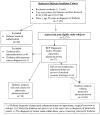Probability of pancreatic cancer following diabetes: a population-based study
- PMID: 16083707
- PMCID: PMC2377196
- DOI: 10.1016/j.gastro.2005.05.007
Probability of pancreatic cancer following diabetes: a population-based study
Abstract
Background & aims: Although diabetes occurs frequently in pancreatic cancer, the value of new-onset diabetes as a marker of underlying pancreatic cancer is unknown.
Methods: We assembled a population-based cohort of 2122 Rochester, Minnesota, residents age > or =50 years who first met standardized criteria for diabetes between January 1, 1950, and December 31, 1994, and identified those who developed pancreatic cancer within 3 years of meeting criteria for diabetes. We compared observed rates of pancreatic cancer with expected rates based on the Iowa Surveillance Epidemiology and End Results registry. In a nested case control study, we compared body mass index (BMI) and smoking status in diabetes subjects with and without pancreatic cancer.
Results: Of 2122 diabetic subjects, 18 (0.85%) were diagnosed with pancreatic cancer within 3 years of meeting criteria for diabetes; 10 of 18 (56%) were diagnosed <6 months after first meeting criteria for diabetes, and 3 were resected. The observed-to-expected ratio of pancreatic cancer in the cohort was 7.94 (95% CI, 4.70-12.55). Compared with subjects without pancreatic cancer, diabetic subjects with pancreatic cancer were more likely to have met diabetes criteria after age 69 (OR = 4.52, 95% CI, 1.61-12.74) years but did not differ significantly with respect to BMI values (29.2 +/- 6.8 vs 26.5 +/- 5.0, respectively). A larger proportion of those who developed pancreatic cancer were ever smokers (92% vs 69%, respectively), but this did not reach statistical significance.
Conclusions: Approximately 1% of diabetes subjects aged > or =50 years will be diagnosed with pancreatic cancer within 3 years of first meeting criteria for diabetes. The usefulness of new-onset diabetes as marker of early pancreatic cancer needs further evaluation.
Figures
References
-
- Brentnall TA, Bronner MP, Byrd DR, Haggitt RC, Kimmey MB. Early diagnosis and treatment of pancreatic dysplasia in patients with a family history of pancreatic cancer. Ann Intern Med. 1999;131:247–255. - PubMed
-
- Canto M, Wroblewski L, Goggins M, Petersen G, Brune K, Yea C, Giardello F, Hruban R. Screening for pancreatic neoplasia in high-risk individuals: The Johns Hopkins Experience. Gastroenterology. 2002;122(Suppl 1):A–17.
-
- Goggins M, Canto M, Hruban R. Can we screen high-risk individuals to detect early pancreatic carcinoma? J Surg Oncol. 2000;74:243–248. - PubMed
-
- Everhart J, Wright D. Diabetes mellitus as a risk factor for pancreatic cancer: a meta-analysis. JAMA. 1995;273:1605–1609. - PubMed
-
- Ragozzino M, Melton LJD, Chu CP, Palumbo PJ. Subsequent cancer risk in the incidence cohort of Rochester, Minnesota, residents with diabetes mellitus. J Chronic Dis. 1982;35:13–19. - PubMed
Publication types
MeSH terms
Grants and funding
LinkOut - more resources
Full Text Sources
Other Literature Sources
Medical
Miscellaneous


